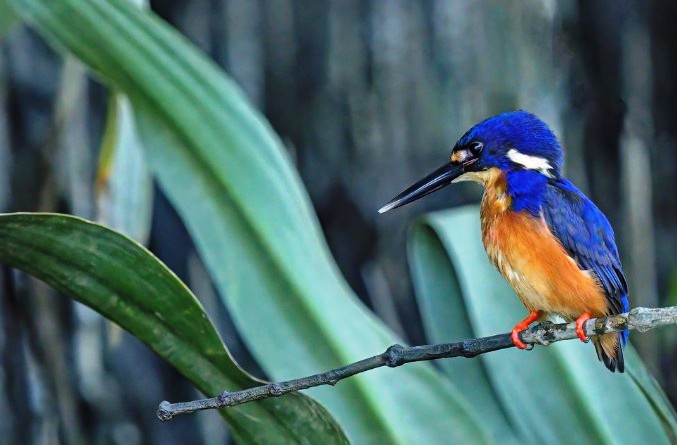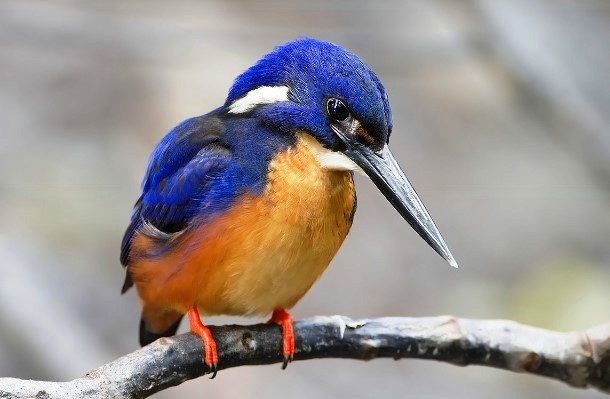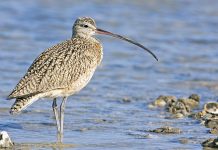The Azure Kingfisher (Ceyx azureus) can be found alone or sometimes in dispersed pairs. From its perch on a low branch, rarely higher than a meter above the water, this beautiful kingfisher spends much of its day staring down. The size is about 175–190 mm in length, including a 45–50 mm bill. This bird is also known as the Blue Kingfisher or Purple Kingfisher. The call of Azure Kingfisher is a shrill peeee peeee, frequently given in flight, mostly when disturbed; uttered by both sexes.
Its bent head occasionally bobbles if it becomes uneasy or excited; it sits for an hour or more looking into the water. When a suitable fish appears, the bird dives down, seizes it, and then transports it back to the porch, where it is eaten head first. Once more fish, crustaceans, or water insects are caught, the bird moves back to its watching position.
There are times when it moves systematically from perch to perch up and down a stream, zigzagging with rapid beatings of stiff wings and long, meteor-like glides. Azure Kingfishers are the Australian counterparts of European river kingfishers, although they have two toes instead of three. Adult pairs usually keep a permanent territory of about 200–500 meters of waterfront, similar to the feeding habits of European species and living along small streams and waterways. In display flights, male Azure Kingfishers chase females up and down streams, often far from nest sites, in flashing zigzags.
Read More – The Crested Kingfisher (Megaceryle lugubris)

It has also been observed that two or three birds have been perched close, facing each other, waving their wings, and whistling shrilly. The nest is a tunnel that both sexes dig out of the bank of a stream using their bills as digging tools. A small chamber is located at the end of the tunnel, which is approximately a meter long.
Throughout northern and eastern Australia, Azure Kingfishers can be found along mangrove-lined waterways and forested coastal streams ranging from the southwest to Mount Lofty Ranges. This colorful kingfisher is also found in lowland New Guinea, its offshore islands, and Moluccas. Three races exist in Australia.
In Australia, there are three forms of the Azure Kingfisher. There is a form of azurea rujicollaris that lives from the Kimberleys in the west to the Cape York Peninsula in the east. It is rather small, with a deep rufous-brown belly and extensive blue and lilac flanks. Another form of A. a. azurea is paler, of medium size, and with a cinnamon-brown belly and less blue and lilac on the flanks; it is now extinct in eastern Australia, from the foot of the Cape York Peninsula to southern Victoria. The third form, A. a. diemenensis of Tasmania, resembles the second in color but is larger.
ADULTS: Both sexes are similar. Its head and back are uniformly rich deep blue, with large buff-white to rufous-buff spots on the forehead and neck. A very short tail with a deep dusky blue above and black below flight feathers, and wings deep blue with dusky black flight feathers. The throat, belly, and undertail coverts are white to buff and merge gradually into deep cinnamon-brown to rufous-brown at the middle. A rich violet-blue suffusion is seen on the sides of the neck, the breast, and the flanks. Their eyes are deep brown. The bill is usually black with a fine white tip. Two front toes, feet orange-red; claws black.
IMMATURES: In adults, the crown is faintly scalloped mid-blue on a deeper blue background; the lower back and rump are mid-blue; the breast and belly are paler, more cinnamon-brown; and the sides of the neck, breast, and flanks are black without any lilac suffusion. At the end of their first year, immature birds appear to molt into adult plumage.
Nesting and breeding seasons occur in September–January in southeastern and eastern Australia; probably October–April in the north during the wet season. The bird lays usually two broods a year, at least in southern regions. Nest a tunnel drilled into the stream bank, enlarged into the small chamber at the end, and loosely lined with fish bones, scales, and remains of crustaceans. The kingfisher lays four to seven eggs, lustrous white; rounded, about 23 x 19 mm. The incubation period is about 20–22 days, for both sexes. Young fledge in 3 to 4 weeks.
Read More – Little Kingfisher (Ceyx pusillus)







